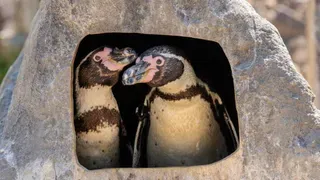March 19, 2018
Failure or Fate? When Adventure Travel Takes a Turn
Jill Gleeson READ TIME: 6 MIN.
It's been a month since I was sent down from Aconcagua, the world's tallest mountain, outside of those behemoths in Asia. But today, as I finally unpacked my duffle, stowing away the gear I'd taken (and mostly never got to use) I broke down and wept. I wanted that summit so badly. It was part of a plan I'd hatched 18 months ago, after my longtime partner ended our relationship in brutal fashion, departing without so much as a forwarding address, never to be heard from again.
I wanted to remake myself into someone stronger, both physically and emotionally, someone who couldn't be destroyed by a breakup, like I nearly had been. And I knew I needed a goal, something to keep me focused on the future, at a time when my whole world wouldn't be awash in pain.
So I decided that I would climb two of the Seven Summits, as the tallest mountains on each continent are collectively known. I successfully ascended Kilimanjaro, at 19,341 feet the highest peak in Africa, last August. It was one of the most challenging things I've ever done and I walked away limping and exhausted, but also triumphant. Aconcagua would be a different story. That mountain would eject me from its slope in just two days, as easily as a hound dog shakes off water after a summer rainstorm.
Ain't No Mountain High Enough
Not everyone fails at their climbs quite so spectacularly. According to Robert Sharp, co-founder of LGBTQ tour operator OUT Adventures, his company's clients have a very high rate of success on adventures like trekking to Everest Base Camp. "In all honesty, in ten years we have only had a handful of people not complete a hike or climb. When it has happened, they are seriously disappointed, and rightly so. In most cases, they require immediate medical attention, usually to address altitude sickness. Once the altitude sickness subsides, they usually find other activities to do at a lower altitude with our support and assistance."
But Everest Base Camp, which is located at 17,600 feet, isn't Aconcagua, which soars to 22,841 feet. Only 30 percent of people who try to summit what's known to South Americans as "The Mountain of Death" actually succeed. I wasn't one of them, a victim, like most, of acute mountain sickness, which can strike any climber anywhere at anytime. I'd only faced the mildest version of it with a short bout of dizziness and nausea on Kili. I had every reason to believe I'd be fine on Aconcagua.
Mountain Majesty
I began experiencing problems not long after my group, led by guides from Inka Expediciones, passed through the gates of Aconcagua Provincial Park. While we were at less than 10,000 feet in elevation, as soon as we began ascending in earnest, the trail winding inexorably up through a wide valley, I found myself gasping for breath. I seemed to be unable to fill my lungs with enough oxygen, but I continued to drag myself forward as best I could, intent on reaching Confluencia, the mountain's approach camp.
It was just five miles from the park gates to the camp, but we hadn't even gone halfway before my legs started to give out. I was as exhausted as I'd been on the endless, eight-hour push to Kili's summit. I didn't understand what was happening to me, but it was humiliating. One of the guides had to stay behind with me as the rest of my group, fit and chipper, marched on.
As soon we reached Confluencia my guide sat me down and filled my canteen, believing I was severely dehydrated. So did the camp doctor, a gorgeous and kind Argentinian woman who looked a lot like a careworn Salma Hayek. She predicted -- as did I, and the guides, too -- that after a good night's sleep and plenty more water I'd be ready to make the five-hour trek to Plaza Francis the next day. Instead, I faded faster than I had the afternoon before.
Just a few hours into the ascent, I began staggering, barely able to keep my feet under me. I wanted to sit, to lay down even, under that bright Argentinian sun and watch the few clouds, puffy and brilliant white, float by overhead. Instead, I drove myself on, until I realized that although I might be able to make it to Plaza Francis, I would not have the energy for the descent. I reached about 13,000 feet before I begged the guide to take me back to camp.
Failure or Fortune?
I had an inkling what was going to happen when my guide brought me in to see the doctor. She was gravely concerned by my vital signs, which had worsened from what they'd been the day before. My blood pressure had risen to 165/110, my heart rate was up to 130 and my oxygen saturation level had plummeted to 84. I wasn't acclimatizing to the altitude.
My poor vitals, combined with my ongoing exhaustion, indicated to the doctor I was getting sicker. I was in real danger, she informed me, gravely but with tenderness. I would have to leave the mountain first thing in the morning. I wish I could say I put up a fight, but I was so weary, so wrung out, I knew that something was seriously wrong. I also knew I'd never be able to make it to base camp with the rest of my group the next day.
And so I came down from Aconcagua just two days after I began. I caught the bus to Mendoza and spent a couple of days kicking around the friendly little city, hanging out in plazas and buying handmade trinkets from the locals, who I gabbed with as much as I could, given my lousy Spanish. I think having a little escapade on my own helped ease the disappointment of my failure.
That was certainly the case with me, but I think that wasn't the only reason why -- crying bouts notwithstanding -- I wasn't quite as heartbroken over my failure to summit Aconcagua as I might have predicted. I came home happier, less anxious and more energized than I've been since my partner left me.
Maybe that's because, for me, climbing Aconcagua was more about daring to try than the ability to complete the challenge. But in my stillness, I can hear that beautiful, brutal mountain calling me back. And I'm just about ready to answer.
Jill Gleeson is a travel and adventure journalist based in the Appalachians of Central Pennsylvania. Find her on Facebook and Twitter at @gopinkboots.







